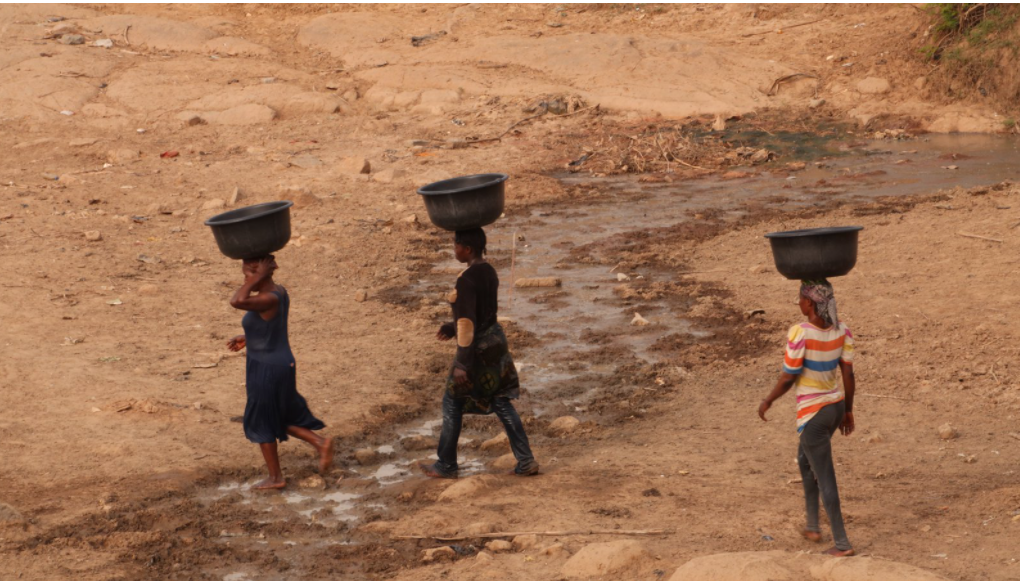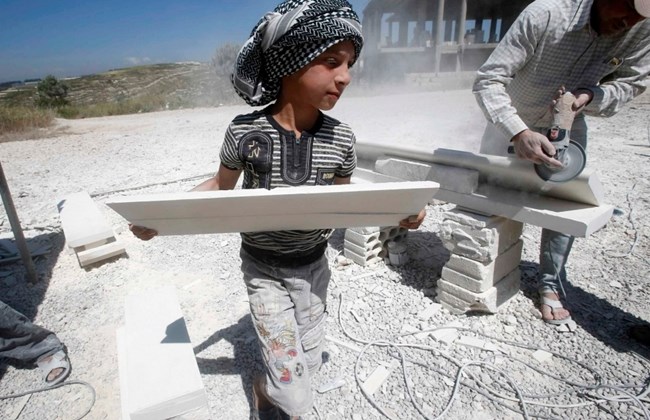
by hms59 | Nov 23, 2021 | Dashboard, Visualization

One morning in February, in Kaffrine Region, Senegal, Kaffia Diallo emerged from her tent. She is happy; her new grandson was born just two days earlier. “A beautiful baby,” she said, “although I wish he weighed a little more.”
Following tradition, they will wait seven days before giving him a name. Surrounded by their herds of cows, sheep and goats, Kaffia helped her daughter with the birth in their tent in the middle of the brush, far from the closest medical center. This is nothing new for Kaffia. She comes from a family of livestock herders who seasonally move their herds from one place to another, along with some 800,000 herders in Senegal and millions of others throughout the Sahel.
“We have always been a family of herders and I began moving our herds when I was 15 years old,” Kaffia explained. “But now that I am old, I stay in the village and take care of my grandchildren.
´One billion children at ‘extremely high risk’ of the impacts of the climate crisis – UNICEF.
´Young people living in the Central African Republic, Chad, Nigeria, Guinea, and Guinea-Bissau are the most at risk of the impacts of climate change, threatening their health, education, and protection, and exposing them to deadly diseases, according to a UNICEF report.
Global average temperatures have increased by more than 1℃ since pre-industrial times. Human emissions of carbon dioxide and other greenhouse gases – are a primary driver of climate change – and present one of the world’s most pressing challenges. … Overall, this would amount to an average temperature rise of 1.1℃
- CO2emissions have increased by about 90%, with emissions from fossil fuel combustion and industrial processes contributing about 78% of the gas emissions increase from 1960 to 2020.
- Over the entire industrial era, some 2.3 trillion tons of carbondioxide have been released to the atmosphere. …
- One of the most promising initiatives and projects are the Carbon Capture Capacity projects.
- Globally, there are 15 large-scale CCS projects in operation, with a further seven under construction.
- The total CO2 capture capacity of these 22 projects is around 40 million tonnes per annum (Mtpa).

by jme43 | Nov 22, 2021 | Dashboard, Visualization
Sanitation facilities safely separate human waste from human contact, but when people don’t have access to safe toilets, they opt to defecate in the open, and exposed human waste is transferred back into people’s food and water resources. About one-fourth of those defecating in the open in the world live in sub-Saharan Africa and they spend an average of 2.5 days per year trying to find a private location to defecate. Women spend extra time looking for a safe place to go and are put can experience gender-based violence in the process.
The use of contaminated drinking water and poor sanitary conditions results in increased vulnerability to water-borne diseases, including diarrhea, cholera, dysentery, and typhoid. More deaths occur among children under 2 years of age living in South Asia and sub-Saharan Africa. It is reported that 115 people in Africa die every hour from diseases linked to poor sanitation, poor hygiene, and contaminated water.
When a person doesn’t have access to clean water and sanitation, they are also at risk of decreased school attendance, missed workdays, malnutrition, and poverty. When girls and women lack access to safe sanitation and water, their education suffers because they experience period poverty and can’t afford menstrual products, clean themselves safely, or access separate bathrooms.
In Africa, especially sub-Saharan Africa, more than a quarter of the population spends more than half an hour per trip to collect water. The task of fetching water tends to fall on women, and this burden can also prevent girls from attending school.

by Stephanie Khabbaz | Nov 22, 2021 | Dashboard, Visualization
“An unemployed existence is a worse negation of life than death itself“
Youth have long been a neglected, underserved and misunderstood population. In many low and middle income countries, youth are not able to enter the labor force in unprecedented numbers, leading to household poverty, inability to secure rewarding livelihoods and lower economic growth. With so much at stake, it is clear why youth development is an important economic development issue.
From 2015 until 2020, also in the wake of COVID‑19 impact, youth unemployment protestations have been significantly increasing across low and middle income countries. Ambitious and talented young people feel extremely hopeless and are looking for any source of light in their situation. Youth unemployment is quickly becoming a global crisis that needs to be primarily addressed.

Meet Amy Windfield, a senior consultant at the World Bank Organization. She works with the Social Protection and Jobs Global Practice at the World Bank. Prior to joining the Bank, Amy consulted for the International Labor Organization within the field of social security and financing. Currently, in her capacity, she provides analytical and operational support on various projects, tackling promotion of efficient and fair labor markets. Amy studied the youth unemployment crisis by better understanding the situation in general and by then providing a deeper and thorough analysis of the root cause problem of youth unemployment with proposed actionable insights and solutions for this global problem across low and middle income countries.

Amy provided us with a glimpse of youth unemployment alarming facts to raise awareness and understand the severity of this global crisis affecting youth generation.
Why Do Young People Experience A Disadvantage In The Labor Market?
A mix of factors should be considered when attempting to answer this question. First and foremost among these, is the lack of sufficient economic growth in many countries. The youth disadvantage is strongly and inversely affected by the business cycle; when an economy is expanding, its youth unemployment rate decreases more than the average, while it increases more than average when an economy is contracting.
A General Look Into The Data
What Has Been Happening?
Youth unemployment certainly also affects high income countries but has a bigger impact on low and middle income countries where there is presence of economic weakness as well as weak education quality. In fact, governments in lower‐income countries are increasingly looking for ways to improve youth employability and earnings, but regularly fail to recognize that the youth employment problem is simply a subset of the overall employment and earnings challenge, which is, in turn, a structural transformation challenge. In other words, employment opportunities in the economy will only improve with economic transformation.
By having a general look at the data, low and middle income countries such as Nigeria, Lebanon, Iran and India are highly affected by youth unemployment compared to high income countries.
When youth unemployment is not taken seriously as a major global issue, low and middle income countries will then experience poverty and economic weakness, as shown in the map below. Concerned countries are for example Sudan, Syria, Lebanon, Nigeria, Iran, for which their respective GDP per capita is low compared to developed countries such as Kuwait, United Arab Emirates, United States and Canada.
A Deeper Look Into The Data
Why Did This Happen?
There is a need to explore more fully youth unemployment causations, which will provide a more nuanced understanding of the association between youth unemployment and other factors.
Amy decided to dig deeper into the data and to take a market systems approach by analyzing the root cause problem of this global crisis rather than only its symptoms, to gain a better detailed understanding and properly share her analysis with the world.
Youth unemployment global problem is affected by several major causal factors.
1- Countries Inflation
From 2015 until 2020, low and middle income countries were suffering from inflation, particularly Sudan, Lebanon and Iran, with a significant inflation increase between 2019 and 2020, mostly due to the pandemic’s impact on the country’s economy. This economy inflation lead to companies’ downsizing and employees’ unemployment.
2- Population Increase Over Time
Over time, an increase in population across low and middle income countries can lead to a rise in the labor force of their community, leading the substantial chunk of population to unemployment. In other words, if a country’s human population exceeds the carrying capacity of its environment, then the populace is more than the amount of available or needed jobs.
3- Exports Of Goods And Services Across Countries
Amy also analyzed another interesting causal factor, which is related to the exports of goods and services for low and middle income countries. The global imports and exports can create a paradigm shift in the market economy of every country. In fact, if a country is facing trade deficit, this will negatively affect its market economy but if a country’s exports exceed its imports, more employment opportunities are provided as it requires more products to export and by then, more people are needed to keep factories running. For example, Iran, Lebanon, Nigeria and India are example of countries where exports of goods and services is low compared to developed countries.
4- Educational Attainment & Literacy Rate Across Countries
Finally, the most important causal factor of youth unemployment in low and middle income countries is the education quality and its attainment. Low and middle income countries lack valuable education and are the ones facing high unemployment rates over time such as Nigeria, Sudan, India & Syria, since education helps in enhancing chances of getting suitable jobs in a continuous competitive market.
Here comes the best part to Amy and to all of us, as well: Finding realistic SOLUTIONS to this global crisis by proposing certain action points and offering valuable insights that could be shared with all countries’ governments as well as organizations to help solve this issue.
How Should Youth Unemployment Solutions in Low and Middle Income Countries Be Designed?

Youth’s transition into employment in low and middle income countries is constrained by the economic development challenges and parses the evidence of the necessity of having programs and policies that will help in speeding that transition.
In fact, building long-term solutions with a holistic approach is the way to go. As per Amy “By understanding the economic geography of the concerned countries, we’re able to identify viable opportunities and create sustainable change, so improvements and job creation last beyond our involvement. A market assessment allows us to understand the needs of potential employers, so we can help ensure the skills young people are developing will match the needs of local economies.”
There are two main strategies for reducing youth unemployment.
1- Implementation of demand side policies to reduce demand-deficient unemployment
Policies to reduce unemployment could be monetary policy such as central banks taking appropriate measures by applying fiscal or also monetary policy measures.
2- Supply side policies to reduce structural unemployment
Supply side policies could be the implementation of education and training to help reduce structural unemployment as well as geographical subsidies to encourage firms to invest in depressed areas and have more flexible labor markets to make it easier to hire and fire workers.
Amy also decided to provide more detailed actionable insights regarding education quality and attainment, knowing its importance in overcoming this global crisis. Education should start early in school and teachers should pay close attention and take care of every child to ensure good educational progress. Moreover, children from families who do not care about their education, should be supported by community programs & financial aids to offer them a fair chance of increasing their education level and make them better qualified for jobs i.e., reduce structural unemployment.
As a conclusion, youth unemployment can be a serious problem, especially in structurally weak geographic regions where firms do not have proper incentives to open branches. Governments have to take suitable measures to fight these high levels of unemployment and by doing so, more people can get back into work and overall quality of life for people is likely to increase. This could mean giving firms the incentive to employ more people or also provide better education for the general public helps in decreasing youth unemployment naturally.
After shedding the light on all those important points and promising solutions that can lead to solve the global problem of youth unemployment, Amy will share her analysis with the International Labor Organization as well, to communicate all of these insights with the governments of the concerned low and middle income countries. Hence, effective programs would be implemented on the long run, leading to sustained, inclusive and sustainable economic growth for full & productive employment as well as decent work for all.
This study is based on youth unemployment data from the World Bank (World Development Indicators).

by gma46 | Nov 22, 2021 | Uncategorized
Life is beautiful for Ethan, the eight years’ old child living in the Netherlands with caring parents, he is enrolled in primary in one of the most prestigious schools of the country; but unfortunately, things are not the same for Alexander, who is living in Rwanda. He was supposed to be attending school like all children of his age, but due to his parents’ bad living conditions and poverty, he was forced to drop out of school and work hard to provide food for his family. This is the hard truth that many children around the world are facing. Children should be treated equally no matter how hard their living conditions are. Thus, extreme measures should be taken to provide inclusive and equitable quality education for all.
Let’s investigate some insights related to the Sustainable Development Goal 4 Quality Education, which aims to: ENSURE INCLUSIVE AND EQUITABLE QUALITY EDUCATION AND PROMOTE LIFELONG LEARNING OPPORTUNITIES FOR ALL. All visualizations were created using the World Development Index Dataset.
If we take a look at primary and lower secondary completion rates since 1990, we notice that a worldwide improvement has been made in the rates of students attending schools; but unfortunately the Sub-Saharan Africa is still behind, despite a slight increase in the attendance rates since 1990.
A closer look at the number of out of school children around the world between 1990 and 2019 shows that despite the decrease in numbers, over half of the total number of out of school children reside in the Sub-Saharan Africa and South Asia.
Let’s investigate deeper the enrolment opportunities in preprimary and tertiary between low income, lower middle income, upper middle income and high income countries. We notice that although enrolment has increased within each category, children don’t have equal enrolment opportunities. Low income countries still have enrolment rates that are extremely lower than lower middle, upper middle and high come countries.
Teacher proficiency is the most important indicator to assess student learning, and unfortunately the % of trained teachers has decreased since 2000 and is still far behind in Sub-Saharan Africa.
Poverty is one of the main reasons why children are obliged to leave school to work and provide for their families. We notice that the average poverty headcount ratio at $1.90 a day is the higher in Sub-Saharan Africa, South Asia and East Asia & Pacific where the highest numbers of deprived children from accessing education are reported.
Lack of financial resources in developing countries is definitely one of the main reasons why many children are not accessing their right to study, many countries like those in Sub-Saharan Africa and South Asia are not able to provide the appropriate funds per student in order to ensure access to education.
Parents definitely have a huge impact on the well-being and success of their children, if parents are not educated, they will not be able to improve their own lives and the lives of their children. Parents’ illiteracy and unemployment would definitely increase the risk of having children dropping out of schools at a very young age in order to work and provide support to their families.
Ultimately, Improving education and quality education is a must, especially in developing countries. Children should learn and they should learn sufficiently. The main goal is not only limited to increasing the number of children attending schools but it goes further to assure that the whole educational system is improved to provide quality education to students.











